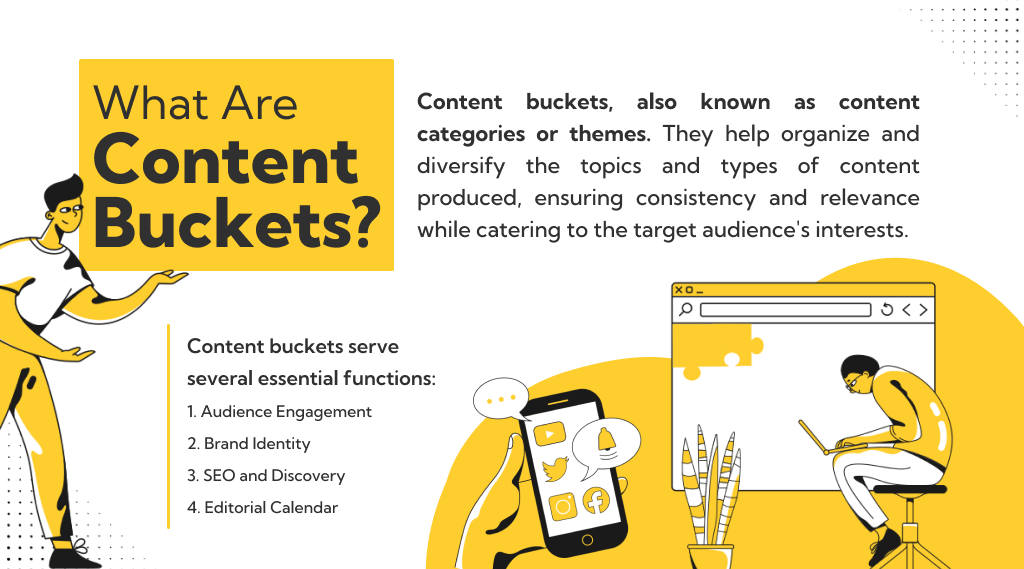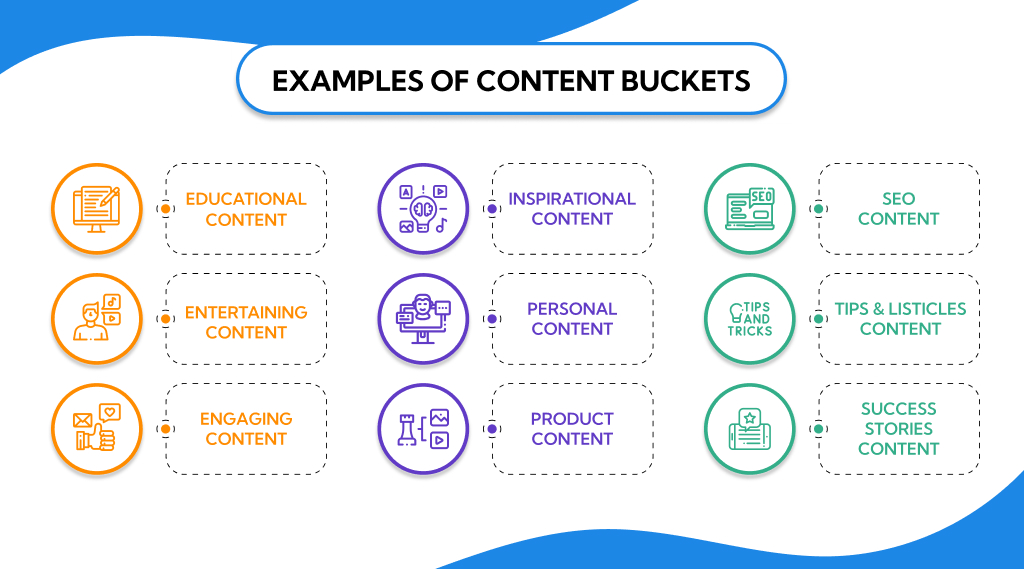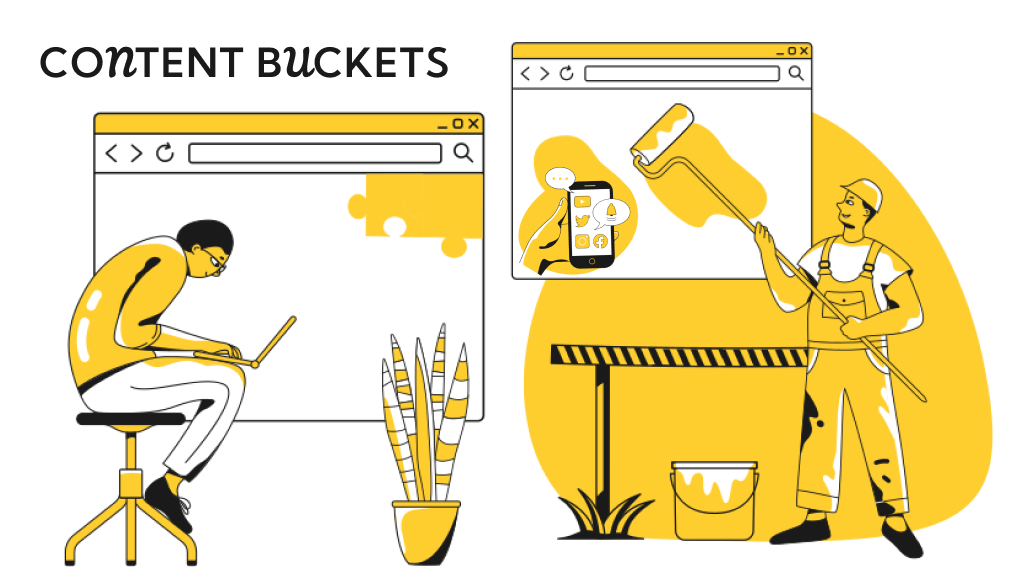Introduction
Content creation is the latest trend. People are consuming content and multiple brands are using social media channels for the promotion of their products or services.
But in this competition, how do we manage the content? The answer is simple, with the help of content buckets.
Content buckets are referred to as content categories that are used in content marketing. They help in organising diverse topics for brand or individual products. They help in maintaining consistency and relevance in content creation.
Content creators use these buckets as guidelines to maintain a balanced and effective content strategy to build trust and connection with their target audience.
What are content buckets?

Content buckets, also known as content categories or themes, are a strategic framework used in content marketing and creation. They help organize and diversify the topics and types of content produced, ensuring consistency and relevance while catering to the target audience’s interests.
Content buckets are like themed boxes for your content. Each box holds a specific type of content, like funny videos or helpful tips, keeping your content strategy organized and interesting.
Examples of content bucket
A content bucket example could be for a health and wellness website. Here are some content buckets and explanations:
Here are some examples of content buckets:

- Educational content
- Entertaining content
- Engaging content
- Inspirational content
- Personal content
- Product content
- SEO content
- Tips and listicles content
- Success stories content
1. Educational content: This bucket includes posts that teach your audience about your product, service, or industry. It educates your audience. Examples include blog posts, how-to videos, infographics, and Q&A sessions.
2. Entertaining content: This bucket targets the audience that likes a bit of fun and takes a more interactive approach to content. Examples include memes, gifs, showcasing a fun day out or holiday, sharing joke posts, and holding contests or giveaways.
3. Engaging content: This bucket includes posts that get your audience to join in with a thread or participate in a post. Examples include asking questions, using polls with multi-choice answers, posting ‘this or that’, and showcasing new products and asking for opinions.
4. Inspirational content: This bucket includes posts that make your audience think, or posts that motivate or inspire them. Examples include motivational or inspirational quotes, memes or gifs with an inspirational theme, sharing something you do that inspires you, and sharing your story of why you started your business.
5. Personal content: This bucket is about increasing your brand awareness by sharing about yourself. Examples include introducing yourself on a regular basis and sharing a little information about yourself.
6. Product content: This bucket focuses on showcasing your products. Examples include high-quality product photos, videos demonstrating how to use it, or posts detailing its features and benefits.
7. SEO content: This bucket is designed to boost your online visibility. Examples include blog posts optimized for specific keywords, how-to guides answering commonly searched questions, or infographics likely to be shared and linked to
8. Tips and listicles content: This bucket provides useful tips or lists on relevant topics. Examples include a list of top trends in your industry, tips for using your product effectively, or a listicle of ideas inspired by your product or service
9. Success stories content: This bucket highlights the successful outcomes achieved through customers using your product or service. Examples include detailed case studies, testimonial videos, or a series of quotes from satisfied customers
How do you create content buckets?
You can create content buckets by categorizing your content ideas and topics into specific themes. Here’s a step-by-step guide on how to create content buckets:
- Identify your content goals
- Understand your audience
- Brainstorm content ideas
- Group content ideas
- Prioritize content buckets
- Generate content ideas for each bucket
- Diversify content formats
- Align with SEO strategy
- Measure and iterate
1. Identify your content goals
Before diving into content creation, determine your overall content marketing goals. Are you aiming to increase brand awareness, generate leads, educate your audience, or drive sales? Understanding your objectives will help you in the making of your content buckets accordingly.
2. Understand your audience
Develop detailed buyer personas to understand your target audience’s demographics, interests, pain points, and preferences. This insight will guide you in creating content that resonates with your audience.
3. Brainstorm content ideas
Conduct brainstorming sessions with your team to generate a list of potential content ideas. Consider using techniques like mind mapping or idea generation frameworks to explore various topics.
4. Group content ideas
Once you have a list of content ideas, categorize them into broad themes or topics. These categories will form the basis of your content buckets. Common content categories may include educational content, product-focused content, customer stories, industry insights, etc.
5. Prioritize content buckets
Assess the relevance and importance of each content bucket based on your goals and audience preferences. Choose buckets that can align to your goal.
6. Create a content calendar
Develop a content calendar outlining when and how you’ll publish content for each bucket. This calendar will help you maintain consistency and ensure that you cover a diverse range of topics over time.
7. Generate content ideas for each bucket
Once you’ve established your content buckets, focus on generating specific content ideas for each category. This could include blog posts, videos, infographics, case studies, podcasts, social media posts, etc.
8. Diversify content formats
Within each content bucket, aim to diversify the content formats to cater to different audience preferences. For example, if one bucket focuses on educational content, you might create blog posts, how-to videos, and downloadable guides on related topics.
9. Align with SEO strategy
Ensure that your content buckets align with your SEO strategy by targeting relevant keywords and addressing common search queries within your industry or niche.
10. Measure and iterate
Keep measuring the performance of your content across different buckets using metrics like engagement, website traffic, leads generated, and conversion rates. Use these insights to build your content strategy.
10 Content buckets ideas to try in 2024
Explore these fresh approaches to engage your audience and create your content strategy to new heights.
Here are ten content bucket ideas that you could consider trying in 2024:
- Interactive content
- Sustainability and ESG
- Emerging technologies
- Remote work solutions
- User-generated content
- Ethical and inclusive practices
- AI-generated content
- Customer challenges and Solutions
- Data privacy and security
- Success stories
Let us understand each of them in detail:
1. Interactive content
The content should be interactive. If you want to catch the attention of your audience, make sure to create unique and catchy content. You can engage with your audience by using polls, quizzes, surveys, and interactive webinars to build community and gather valuable insights.
2. Sustainability and ESG
Most of the big brands use sustainability terms to do their marketing. You might have seen big brands promoting environment friendly campaigns, it is all part of their trust building process. You can also explore environmental, social, and governance (ESG) topics to showcase your commitment to sustainability and corporate responsibility. This helps in building brand awareness and credibility.
3. Emerging technologies
For better content strategy, it is essential to use better and modified technologies. You can use various high tech softwares and technologies like AI, blockchain, and quantum computing to position your brand. You can even take help from these technologies to get content ideas and marketing strategies.
4. Remote work solutions
Create content around remote work trends, productivity hacks, and collaboration tools..
5. User-generated content
User generated content is the content that is created and shared by your customer. It is always the best practice to gain authority in your field. You can encourage your customers to share their experiences with your product through reviews, testimonials, and case studies. It helps in gaining trust and authenticity.
6. Ethical and inclusive practices
Highlight your company’s commitment to diversity, equity, and inclusion (DEI) with content on inclusive hiring and workplace practices.
7. AI-generated content
Experiment with AI-generated content like chatbots and automated responses for customer support and content personalization. Take help from AI to create content.
8. Customer challenges and solutions
If you are creating content, it is always better to know your target audience and their problems. Address common pain points your users encounter, offering solutions and best practices.
9. Data privacy and security
You might have seen on some websites that their landing page talks about asking permissions. Educate your audience on data privacy, cybersecurity, and compliance, establishing trust and credibility.
10. Success stories
Share in-depth stories of how customers have achieved remarkable results using your SaaS product, emphasizing real-world value and ROI.
Content buckets VS. content pillars: what is the difference?
| Aspect | Content Buckets | Content Pillars |
| Definition | Categories or themes that group content ideas | Core topics or themes that guide content strategy |
| Purpose | Organize content ideas into broad categories | Define overarching topics for content creation |
| Flexibility | Provide flexibility for diverse content topics | Provide a framework for content creation and alignment |
| Focus | Focus on organizing content ideas into groups | Focus on defining core themes for content strategy |
| Scope | Generally broader in scope, encompassing various topics | Narrower in scope, representing key focus areas |
| Relationship | Content buckets can be organized under content pillars | Content pillars guide and inform the content buckets |
| Implementation | Created based on audience interests, marketing goals, and content themes | Established based on brand identity, expertise, and core messaging |
| Examples | – Educational content bucket – Product-related content bucket – Industry insights bucket | – Sustainability pillar – Innovation pillar – Customer success pillar |
| Usage | Used to organize and categorize content ideas for planning and creation | Used to guide content strategy and maintain consistency across content creation |
Both content buckets and content pillars are useful tools for organizing and guiding content creation. However, their functions differ slightly. Content buckets focus on categorizing content ideas, while content pillars define the broader themes that guide the content strategy. These themes should align with the brand identity and messaging.
Conclusion
Content buckets enable a brand to diversify its offerings, targeting different segments of its audience with content, ultimately leading to higher engagement and retention rates. They ensure consistency in messaging, fostering a stronger and more recognizable brand identity.
Furthermore, content buckets enhance a brand’s SEO efforts by organizing content around specific themes, making it more discoverable by search engines.
Efficiency is another key advantage, as content planners and creators can work more systematically, saving time and resources. This approach also supports effective content scheduling and aligns with overarching marketing strategies.
Above all, content buckets are adaptable, allowing brands to remain relevant by adjusting their content to evolving audience interests and market trends. In conclusion, content buckets are a fundamental component of modern content marketing, helping brands engage, inform, and grow while maintaining a structured and consistent presence in the digital landscape.
With revvgrowth.com, you will find exclusive guides on everything SaaS- from content marketing to execution. Check out revvgrowth.com today!


